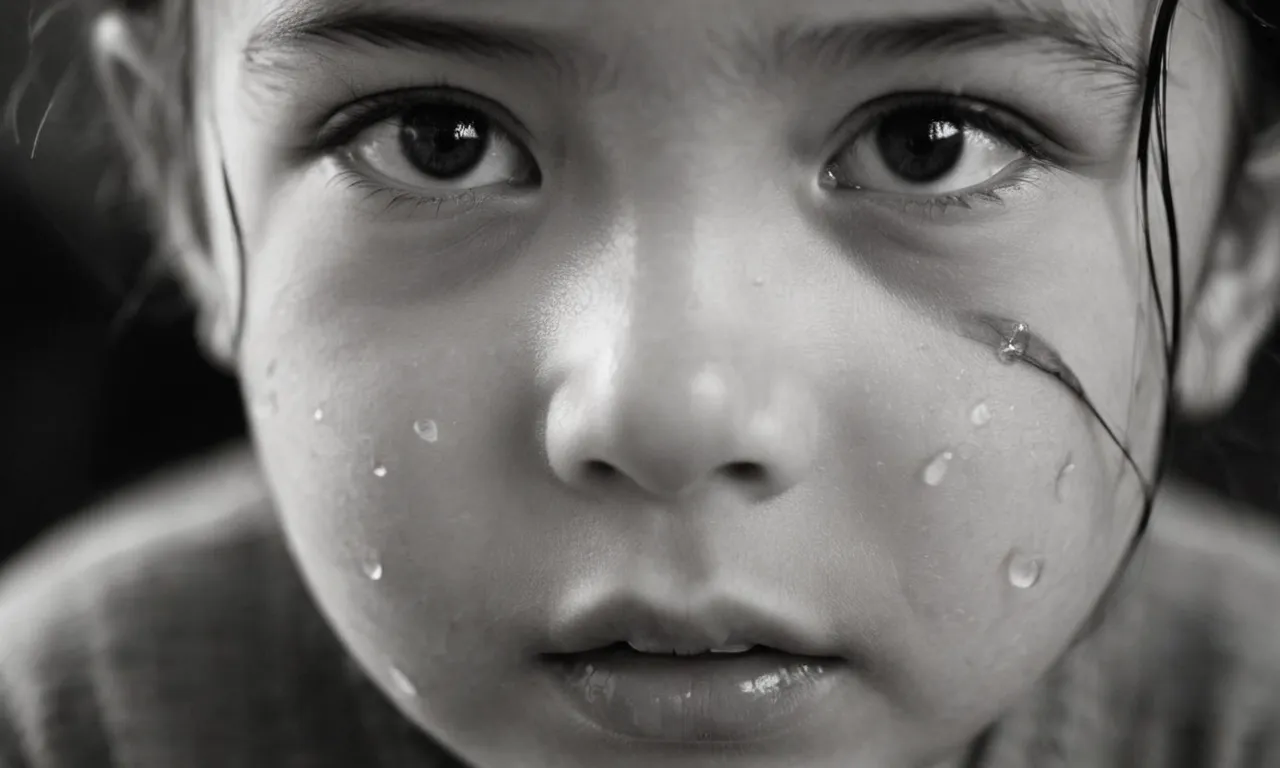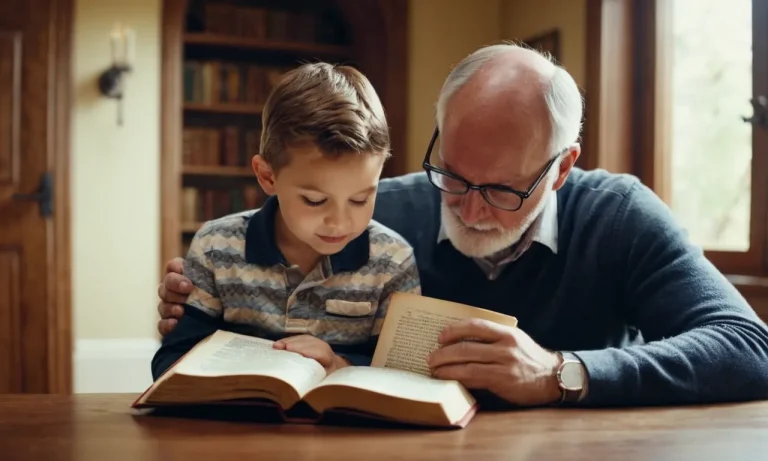Where Is God When A Child Suffers?
The suffering of children is one of the most heartbreaking things anyone can witness. When we see children enduring pain, sickness, abuse, or deprivation, we naturally wonder why a loving God would allow such tragedy.
This question has been pondered by theologians, philosophers, and grieving parents for centuries.
If you’re short on time, here’s a quick answer: While there may not be a fully satisfying intellectual answer to this dilemma, Scripture teaches that God is always present with those who suffer, weeping with them, holding them close, and ultimately working to redeem their pain.
In this in-depth article, we’ll discuss perspectives on child suffering and God’s presence from the Bible, Christian history, and modern psychology and counseling.
Biblical Perspectives on Child Suffering
The Problem of Evil and an All-Powerful, Good God
The existence of child suffering poses a difficult theological question: If God is all-good and all-powerful, why does He allow innocent children to suffer? Various solutions have been proposed, but ultimately there is tension between God’s qualities that may not be fully resolved.
God’s Presence in Our Suffering
Though an explanation may not satisfy, the Bible gives hope that God is present with those who suffer, weeping with those who weep (John 11:35). His desire is to comfort and heal, as a loving parent comforts a child (Isaiah 66:13).
God’s presence gives strength to endure suffering with dignity and hope.
Examples of Child Suffering in Scripture
Several biblical narratives deal with child suffering. The story of David’s infant son who became ill and died (2 Samuel 12) illustrates the raw anguish of a grieving parent. The massacre of innocent infants in Bethlehem by Herod (Matthew 2:16-18) conveys the deepest evil of child suffering.
Yet God was present through it all, ultimately bringing hope out of despair.
Historical Christian Views on God and Child Suffering
Augustine on Evil as Privation
The influential theologian Augustine of Hippo (354-430 AD) argued that evil is not a substance or force in its own right, but rather the absence or corruption of good. Suffering, Augustine contended, entered the world through human sin and disobedience towards God.
He saw suffering as one of the consequences of the Fall in the Garden of Eden. For Augustine, God did not directly will suffering, but permitted it in order to bring about greater goods. He believed that God allows suffering to purify and strengthen faith, develop virtues, inspire compassion, and warn of the dangers of sin.
Irenaeus on Human Growth and Suffering
The early church father Irenaeus (130-202 AD) took a broader view of suffering’s role in human development. He argued that suffering provides opportunities for spiritual and moral growth that are not possible in paradise.
Irenaeus believed that God permits suffering because human beings are intended for spiritual maturity, not a static utopia. While God did not introduce evil and suffering into creation, he causes them to work for the greater good.
For Irenaeus, even the suffering of a child has this potential for soul-making and character development.
Alternate Perspectives from Church History
While Augustine and Irenaeus justified child suffering as part of God’s ultimate plan, others in church history have questioned this reasoning. Some ask whether soul-making requires the degree and intensity of suffering experienced by children.
Others argue that God should protect the innocent and that the suffering of children cannot lead to any good. Rabbi Harold Kushner, reflecting on the death of his son, concluded that God is not in control of each event but rather accompanies us in our suffering.
Process theologians portray God as empathetic but inherently limited in power to prevent evil. Liberation theology focuses action to relieve unjust social structures causing child suffering. The historical conversation continues on how to understand God’s role in allowing innocents to suffer.
Modern Psychology, Counseling, and Child Suffering
Attachment Theory and Early Childhood Trauma
According to attachment theory pioneer John Bowlby, early experiences with caregivers shape a child’s internal working model of relationships. Traumatic events like abuse, neglect, or loss of a caregiver in early childhood can severely damage a child’s sense of safety and trust, leading to insecure attachment styles that persist into adulthood (Ainsworth & Bell, 1970).
Children who experience early childhood trauma like abuse are at higher risk for long-term issues like post-traumatic stress disorder (PTSD), depression, anxiety disorders, substance abuse, and difficulty maintaining healthy relationships (NCTSN, 2021).
Providing traumatized children with psychological first aid, trauma-focused therapy, and caregivers who model secure attachment can mitigate negative outcomes.
PTSD, Toxic Stress, and Impacts on Development
Toxic stress from adverse childhood experiences (ACEs) like trauma or neglect can alter brain development and lead to health issues across the lifespan (Center on the Developing Child, 2022).
Childhood PTSD specifically involves reactions like reliving traumatic events, avoidance behaviors, negative thoughts/feelings, and hyperarousal. These can interfere with developmental tasks like identity formation, mastery of skills, and building autonomy (Cohen et al., 2022).
Best Practices for Counseling Suffering Children
Counseling practices found effective for helping suffering children include:
- Trauma-focused cognitive behavioral therapy (TF-CBT)
- Play therapy to express feelings in developmentally appropriate ways
- Attachment-based family therapy focusing on trust/communication
- Peer support groups to reduce isolation/self-blame
No matter the approach, counselors should provide compassion, stability, and tools for emotional regulation. They can help reframe negative self-perceptions and build self-efficacy. With caring support, children can gain hope and meaning despite hardship.
Where is God in a Child’s Pain? Finding Hope and Healing
God Weeps with Us in Our Sorrow
When an innocent child suffers, it can shake our faith and lead us to ask “Where are you God?”. Yet the Bible reminds us that God is near to the brokenhearted and saves those crushed in spirit (Psalm 34:18).
Though an all-powerful God allows suffering for reasons we cannot yet grasp, He still feels and shares in our pain. Just as Jesus wept at the tomb of His friend Lazarus (John 11:35), God weeps with us in our anguish. We are not alone.
Suffering Can Develop Christlike Character
While suffering is painful and undesirable, God can use it to produce positive change if we allow Him. As we turn to God in our pain, He can develop virtues like patience, humility, compassion for others.
The Bible says “we also rejoice in our sufferings, because we know that suffering produces perseverance; perseverance, character; and character, hope” (Romans 5:3-4). Though we wish for the suffering to end, we can have hope that God will use it for good in our lives.
God Works for Ultimate Redemption from Suffering
Suffering is a result of this fallen, imperfect world tainted by sin. Yet the Bible promises that God will one day redeem all our pain and make all things new. Revelation 21:4 declares “He will wipe every tear from their eyes.
There will be no more death, or mourning or crying or pain, for the old order of things has passed away.” Until then, God invites us to trust that He can bring beauty from ashes, and turn wailing into dancing (Isaiah 61:1-3).
With faith in God’s redemption, we can have strength to endure present sufferings.
Conclusion
The dilemma of child suffering reaches to the depths of our hearts. While complex philosophies have been constructed in seeking to reconcile this tragedy with belief in a good, all-powerful God, perhaps the most meaningful answers are found in simple presence.
Scripture teaches that God draws nearest to those enduring sorrow, holding the sufferer close. And as helpers come alongside both victims and families, we become His hands to bind up wounds, attending to immediate needs first and ultimate questions later.
There are no easy explanations for child suffering, but God has promised to ultimately redeem all pain and dry every tear.







